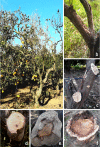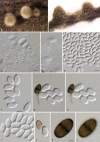Lasiodiplodia mitidjana sp. nov. and other Botryosphaeriaceae species causing branch canker and dieback of Citrus sinensis in Algeria
- PMID: 32433708
- PMCID: PMC7239386
- DOI: 10.1371/journal.pone.0232448
Lasiodiplodia mitidjana sp. nov. and other Botryosphaeriaceae species causing branch canker and dieback of Citrus sinensis in Algeria
Abstract
Several Botryosphaeriaceae species are known to occur worldwide, causing dieback, canker and fruit rot on various hosts. Surveys conducted in ten commercial citrus orchards in the northern region of Algeria revealed five species of Botryosphaeriaceae belonging to three genera associated with diseased trees. Morphological and cultural characteristics as well as phylogenetic analyses of the internal transcribed spacer (ITS) region and the translation elongation factor 1-alpha (tef1-α) identified Diplodia mutila, Diplodia seriata, Dothiorella viticola, Lasiodiplodia mediterranea and a novel species which is here described as Lasiodiplodia mithidjana sp. nov.. Of these, L. mithidjana (14.1% of the samples) and L. mediterranea (13% of the samples) were the most widespread and abundant species. Pathogenicity tests revealed that L. mediterranea and D. seriata were the most aggressive species on citrus shoots. This study highlights the importance of Botryosphaeriaceae species as agents of canker and dieback of citrus trees in Algeria.
Conflict of interest statement
The authors have declared that no competing interests exist.
Figures



Similar articles
-
Characterization and Pathogenicity of Botryosphaeriaceae Species Obtained from Avocado Trees with Branch Canker and Dieback and from Avocado Fruit with Stem End Rot in Chile.Plant Dis. 2019 May;103(5):996-1005. doi: 10.1094/PDIS-07-18-1131-RE. Epub 2019 Mar 6. Plant Dis. 2019. PMID: 30840843
-
Characterization and Pathogenicity of Diplodia, Lasiodiplodia, and Neofusicoccum Species Causing Botryosphaeria Canker and Dieback of Apple Trees in Central Chile.Plant Dis. 2022 Mar;106(3):925-937. doi: 10.1094/PDIS-06-21-1291-RE. Epub 2022 Mar 6. Plant Dis. 2022. PMID: 34664980
-
Botryosphaeriaceae as potential pathogens of prunus species in South Africa, with descriptions of Diplodia africana and Lasiodiplodia plurivora sp. nov.Mycologia. 2007 Sep-Oct;99(5):664-80. doi: 10.3852/mycologia.99.5.664. Mycologia. 2007. PMID: 18268901
-
Elsinoë fawcettii and Elsinoë australis: the fungal pathogens causing citrus scab.Mol Plant Pathol. 2011 Feb;12(2):123-35. doi: 10.1111/j.1364-3703.2010.00663.x. Epub 2010 Oct 1. Mol Plant Pathol. 2011. PMID: 21199563 Free PMC article. Review.
-
Vascular Streak Dieback: A Novel Threat to Redbud and Other Woody Ornamental Production in the United States.Plant Dis. 2025 May;109(5):953-970. doi: 10.1094/PDIS-04-24-0905-FE. Epub 2025 Mar 3. Plant Dis. 2025. PMID: 39115954 Review.
Cited by
-
Species of Botryosphaeriaceae associated with citrus branch diseases in China.Persoonia. 2021 Dec;47:106-135. doi: 10.3767/persoonia.2021.47.03. Epub 2021 Jan 13. Persoonia. 2021. PMID: 37693792 Free PMC article.
-
Fungal canker agents in apple production hubs of Iran.Sci Rep. 2021 Nov 22;11(1):22646. doi: 10.1038/s41598-021-02245-8. Sci Rep. 2021. PMID: 34811444 Free PMC article.
-
Occurrence and infective potential of Colletotrichum gloeosporioides isolates associated to Citrus limon var Eureka.Biotechnol Rep (Amst). 2021 Jun 22;31:e00651. doi: 10.1016/j.btre.2021.e00651. eCollection 2021 Sep. Biotechnol Rep (Amst). 2021. PMID: 34277364 Free PMC article.
-
https://botryosphaeriales.org/, an online platform for up-to-date classification and account of taxa of Botryosphaeriales.Database (Oxford). 2021 Oct 15;2021:baab061. doi: 10.1093/database/baab061. Database (Oxford). 2021. PMID: 34651182 Free PMC article.
-
Lasiodiplodia theobromae as a causal pathogen of leaf blight, stem canker, and pod rot of Theobroma cacao in Malaysia.Sci Rep. 2022 May 27;12(1):8966. doi: 10.1038/s41598-022-13057-9. Sci Rep. 2022. PMID: 35624295 Free PMC article.
References
-
- FAO. 2020. Available from: http://www.fao.org. [accessed March 18th, 2020].
-
- MADR. National agricultural statistics 2015. Algiers: Ministry of Agriculture and Rural Development; 2015.
-
- Khanchouch K, Pane A, Chriki A, Cacciola SO. Major and emerging fungal diseases of Citrus in the Mediterranean region. Citrus Pathology. 2017:1 10.5772/66943. - DOI
-
- Bové JM. Virus and virus-like diseases of citrus in the Near East region. Rome: FAO; 1995.
-
- Cohen M. Diagnosis of young tree decline, blight and sand hill decline of citrus by measurement of water uptake using gravity injection. Plant Disease Reporter. 1974;58(9):801–805.
Publication types
MeSH terms
Substances
LinkOut - more resources
Full Text Sources

